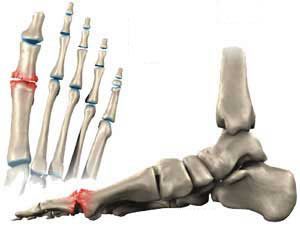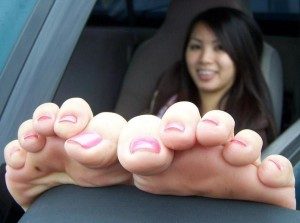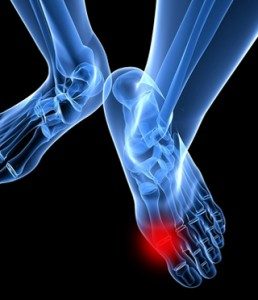Hallux Limitus
 The medical term for the big toe is “Hallux.” Hallux Limitus then is the loss of motion to the big toe joint. The big toe should have a normal range of upward (dorsiflexion) motion of 50 to 90 degrees depending in which literature you review. The big toe is an integral part of gait and the propulsion of the body forward when it flexes upward and pushes off the ground. With limited motion, the big toe will not propel the body forward and other joints of the body will need to compensate, putting more strain through the rest of the foot and lower extremity. This will lead to an inefficient gait pattern and increased fatigue and pain. Over time, the decrease in motion will lend to jamming of the joint. Eventually the joint cartilage will become eroded leading to arthritis (degenerative joint disease) and even less motion and more pain. Now that the joint has become arthritic, any motion will cause increased pain. Since the joint has limited motion now the adjacent will have more stress, eventually the other joints will also developed arthritic changes.
The medical term for the big toe is “Hallux.” Hallux Limitus then is the loss of motion to the big toe joint. The big toe should have a normal range of upward (dorsiflexion) motion of 50 to 90 degrees depending in which literature you review. The big toe is an integral part of gait and the propulsion of the body forward when it flexes upward and pushes off the ground. With limited motion, the big toe will not propel the body forward and other joints of the body will need to compensate, putting more strain through the rest of the foot and lower extremity. This will lead to an inefficient gait pattern and increased fatigue and pain. Over time, the decrease in motion will lend to jamming of the joint. Eventually the joint cartilage will become eroded leading to arthritis (degenerative joint disease) and even less motion and more pain. Now that the joint has become arthritic, any motion will cause increased pain. Since the joint has limited motion now the adjacent will have more stress, eventually the other joints will also developed arthritic changes.
Symptoms
 The pain is usually associated with any movement of the big toe joint. Patients will describe a deep achy to sharp pain with use of the joint. If a bone spur develops, there can be pain over the top of the extra bone growth as well. There is usually limited to no pain when there is no weight on the big toe.
The pain is usually associated with any movement of the big toe joint. Patients will describe a deep achy to sharp pain with use of the joint. If a bone spur develops, there can be pain over the top of the extra bone growth as well. There is usually limited to no pain when there is no weight on the big toe.
Causes
Hallux limitus can be as a result of genetics or overuse. If there is a genetic predisposition to limited motion in the joint, the eventual arthritis will cause pain and decreased function. Other patients will develop arthritis in the joint from trauma and or overuse injuries. This arthritis then will lead to limited motion and pain and decreased function. This becomes a continuous cycle of decreased motion, arthritis, extra bone formation, jamming of the joint and so on.
Diagnosis
Clinical evaluation involves range of motion testing, gait analysis and thorough history of the pain and symptoms. X-ray evaluation is important to investigate the amount of joint narrowing and extra bone (spur) formation in the joint.
Treatment
 The scope of conservative treatments for hallux limitus is narrow. Wider shoe gear and accommodation for the deformity can be used to take the pressure off the area. Using stiff soled shoes to limit the amount of motion can be helpful. Custom molded orthotics can take some pressure off the big toe and redistribute the forces of the ground through the rest of the foot. Injections of catabolic steroid (cortisone) into the joint can reduce the inflammation and scar tissue. This type of injection often brings temporary relief. Several injections over many weeks of a normal joint fluid substitute (sodium hyaluronate) can increase the lubrication of the joint, often decreasing pain. In most cases surgery will be warranted. The most common surgical procedure is a cheilectomy. In this case, the joint is cleaned up of all scar tissue and spurs to allow for better motion. Recovery is very rapid with this procedure, but may not be a good option for severe arthritis cases. A arthrodesis (joint fusion) may be indicated in severe arthritis.
The scope of conservative treatments for hallux limitus is narrow. Wider shoe gear and accommodation for the deformity can be used to take the pressure off the area. Using stiff soled shoes to limit the amount of motion can be helpful. Custom molded orthotics can take some pressure off the big toe and redistribute the forces of the ground through the rest of the foot. Injections of catabolic steroid (cortisone) into the joint can reduce the inflammation and scar tissue. This type of injection often brings temporary relief. Several injections over many weeks of a normal joint fluid substitute (sodium hyaluronate) can increase the lubrication of the joint, often decreasing pain. In most cases surgery will be warranted. The most common surgical procedure is a cheilectomy. In this case, the joint is cleaned up of all scar tissue and spurs to allow for better motion. Recovery is very rapid with this procedure, but may not be a good option for severe arthritis cases. A arthrodesis (joint fusion) may be indicated in severe arthritis.


